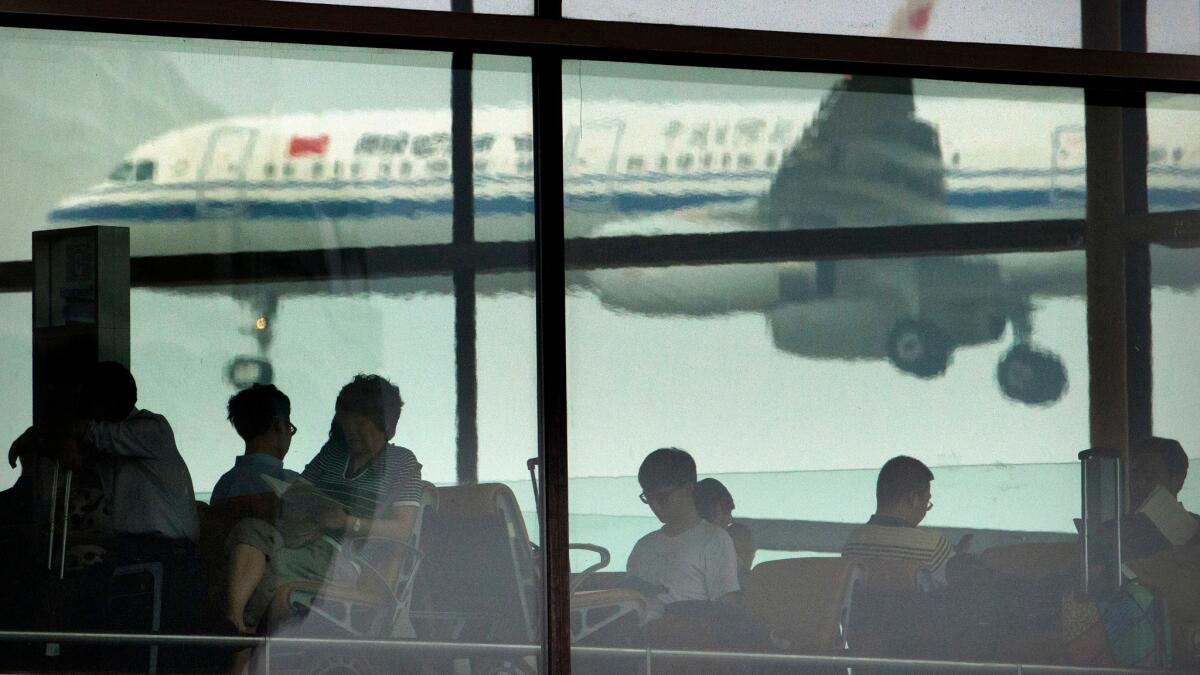Op-Ed: When the rich rub our noses in their wealth, we get angry. But they go ballistic

There’s road rage and bike rage, and there’s even computer rage. (Did you hear about the Colorado man cited by police after he shot his recalcitrant computer eight times?) And there’s also air rage.
A passenger on an airliner becomes belligerent, drunk, noncompliant with rules, or has some sort of emotional outburst. At its most innocuous, it’s unpleasant. At its worst, flight attendants and passengers have been threatened or injured, and flights have been diverted for emergency landings and arrests. Although rare, air rage is on the rise.
There are some obvious reasons why: flight delays, TSA lines so interminable they cause passengers to miss flights, ever-higher ticket prices, ever-smaller seats. And the not-so-obvious: A recent paper published in the Proceedings of the National Academy of Sciences fingered issues of social class.
Katherine DeCelles of the University of Toronto and Michael Norton of Harvard studied more than 1,000 air rage incidents over the course of nearly 1 million flights with one major airline (its identity was kept confidential). They looked for predictors of bad behavior. How far seats tilted back, impinging on the space of a fellow passenger, wasn’t a predictor. But smaller seats, flight delays and longer flight durations all increased the incidence of air rage. After controlling for these logical factors, the authors also found two other major predictors.
First, if a plane had a first-class section, the incidence of air rage more than tripled among coach passengers. That matches the air rage effect of a flight being delayed more than nine hours. Blame that curtain separating Us from Them, that gentle admonition to not dare use their bathroom, the smell of warm cookies wafting back to the hungry in coach.
Second, if coach passengers have to walk through first class to get to their seats, rather than entering mid-plane, it causes an even higher incidence of air rage — about a seven-fold increase, equivalent to enduring more than a 15-hour delay.
When the going gets tough, the obnoxious tend to pick on someone weaker. Fecal matter rolls downhill.
The findings make sense. An extensive literature shows that being a socioeconomic have-not is bad for your health. It increases the odds of major depression and the likelihood of antisocial or criminal behavior. An even bigger predictor of those bad outcomes is the noticeable magnitude of socioeconomic inequality — how much the have-nots’ noses are rubbed in their bad fortune as they scurry through life’s equivalents of the first-class section on an airplane. More than poverty, it’s poverty amid plenty that enrages us.
And it isn’t only the hoi polloi who are getting angry. When coach passengers walk through first class, it causes a more than 10-fold increase in the incidence of air rage among first-class passengers, and the increase is disproportionately in belligerent behavior.
Conspicuous loutishness among the ruling class should be no surprise. Work by researchers at UC Berkeley has shown that, on average, the wealthy are less “prosocial,” generous and honest than the rest of us. For example, one field study showed that wealthier people — as assessed by the cost of their cars — were less likely to stop for pedestrians in crosswalks than poorer folks.
The visibility of inequality seems central to such results. In 2015, Yale researchers reported on a social cooperation game in which participants could choose to use some of their resources in ways that were either cooperative or selfish.
In general, the players were cooperative about half the time. If invisible inequality was introduced — for instance, if some participants secretly started with more resources than others — it had no effect on either group’s behavior. But if the inequality was visible, levels of cooperation among the conspicuously “wealthy” plummeted, while levels among the experimental “poor” stayed the same. Displays of wealth, in an experimental economics game or in the first-class section of an airliner as the huddled masses shuffle by, drives up entitled behavior.
Here’s another interesting aspect of the air rage study. In the heavy news coverage it got, including in this newspaper, few of the stories touched on the finding that conspicuous inequality makes first-class passengers even more obnoxious than coach passengers.
More importantly, none made note of something else: Logic would indicate that air rage in coach ought to consist of someone in a frothing state, sprinting up the aisle into first class, leading his fellow oppressed passengers in a rousing rendition of “One Day More” from “Les Mis,” and berating the well-to-do. That kind of thing almost never happens.
Instead, the frothing passenger is a jerk to the poor flight attendant who has no choice but to absorb it, or to the hapless grandmother crammed in to the next seat. It’s the same with primates displacing aggression: When the going gets tough, the obnoxious tend to pick on someone weaker. Fecal matter rolls downhill.
The patterns the air rage studies reveal go far beyond the satisfaction ratings we give to the airlines and the general misery of air travel. They show us, for example, that when social inequality drives up rates of crime by the poor, it’s overwhelmingly going to be the poor victimizing the poor. And that is so much the way of the world, we barely even notice.
Robert Sapolsky is a professor of neuroscience at Stanford University and a contributing writer to Opinion.
Follow the Opinion section on Twitter @latimesopinionand Facebook
More to Read
A cure for the common opinion
Get thought-provoking perspectives with our weekly newsletter.
You may occasionally receive promotional content from the Los Angeles Times.






